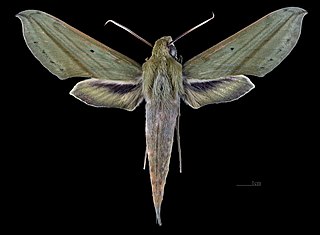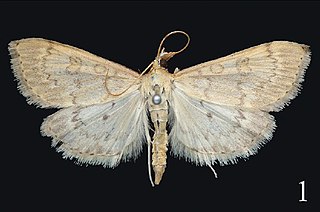
Curetis bulis, the bright sunbeam, is a species of butterfly belonging to the lycaenid family. It is found in Asia.
Hypodrasia is a genus of moth in the family Gelechiidae. It contains the species Hypodrasia acycla, which is found in the Philippines (Luzon).

Idaea straminata, the plain wave, is a moth of the family Geometridae. It is found in Europe including West Russia and Balkans.

Udea prunalis is a moth of the family Crambidae. It is found in Europe and China. The species was first described by Matthew Denis and Ignaz Schiffermüller in 1775. In the Butterfly Conservation's Microlepidoptera Report 2011 this species was classified as common in the UK.

Parapoynx stratiotata, the ringed china-mark, is a moth of the family Crambidae. The species was first described by Carl Linnaeus in his 1758 10th edition of Systema Naturae. It is found in Europe where the distribution area extends in the north to the British Isles including Ireland and in the south to Sardinia, Sicily and Greece. The species is also found across the Palearctic in North Africa, Lebanon, Turkey, Azerbaijan, Kyrgyzstan, Uzbekistan and China..

Merulempista rubriptera is a moth of the family Pyralidae. It is known from China.

Xylophanes elara is a moth of the family Sphingidae first described by Herbert Druce in 1878. It is known from Paraguay, Suriname, Venezuela, Bolivia and Brazil.

Scoparia indistinctalis is a species of moth in the family Crambidae. It is endemic to New Zealand.
Stenoma adoratrix is a moth of the family Depressariidae. It is found in Bolivia.
Stenoma anetodes is a moth of the family Depressariidae. It is found in Guyana.
Antaeotricha modulata is a species of moth of the family Depressariidae. It is found in Brazil, Guyana and French Guiana.
Paraspastis circographa is a moth of the family Depressariidae and the only species in the genus Paraspastis. It is found in Guyana.
Chlamydastis synedra is a moth of the family Depressariidae. It is found in Paraguay.
Lecithocera decorosa is a moth in the family Lecithoceridae. It was described by Alexey Diakonoff in 1968. It is found on Luzon in the Philippines.

Udea curvata is a moth in the family Crambidae. It was first described by Zhang and Li in 2016. It is found in Tibet, China.
Antaeotricha gubernatrix is a species of moth in the family Depressariidae. It was described by Edward Meyrick in 1925. It is found in Peru.

Charaxes affinis is a butterfly in the family Nymphalidae. It was described by Arthur Gardiner Butler in 1866. It is found in the Indomalayan realm.

Austrocidaria lithurga is a species of moth in the family Geometridae. It is endemic to New Zealand. This moth is classified as at risk, naturally uncommon by the Department of Conservation.

Ichneutica panda is a species of moth in the family Noctuidae. It is endemic to New Zealand and only found in central and southern parts of the South Island. The species has not been collected in Canterbury since the late 1950s and has not been seen at The Wilderness scientific reserve since 1941. This species is similar in appearance to Ichneutica falsidica however I. panda lack or have indistinct black dashes on their edge of their hindwings. I. panda inhabit shrubland from alpine zones down to river terraces and adults are on the wing between December and February. The life history of this species is unknown as is the host species of the larvae.

Meterana badia is a species of moth in the family Noctuidae. This species is endemic to New Zealand.











